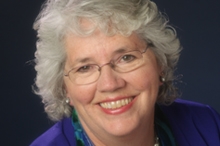

JoAnn was recognized as a White House Champion of Change in Community Resilience and Preparedness.
Getting people to think about and plan for an event that they hope will never happen is hard! Yet, for the past 20+ years, that's what I have been doing - teaching people how to prevent fires and prepare for disasters. The disaster message has been "be prepared to be on your own for at least 3 days," and over the years, we have seen statistics show that people have been gradually hearing our message and taking actions to be prepared.
For the past 2 1/2 years, I have had the great fortune of managing a Regional Catastrophic Preparedness Grant project that focused on motivating people to prepare for catastrophic events. Yes, bigger than an emergency, more powerful than a disaster, we are talking about catastrophic! Our dilemma: how to introduce the term "catastrophic" to the public without scaring them or causing them to feel so overwhelmed that they do not prepare at all.
The project team hired a marketing firm to help research how to motivate people to prepare for the unthinkable. We used focus groups to find out what would motivate people to take action to prepare for longer than three days and who would be the best to deliver the messages.
Armed with the information gathered, we set out to create a platform for introducing the concept that events that are bigger than disasters are happening more frequently and people need to be prepared to be self-sufficient for a minimum of 7 - 10 days. The name of the campaign, “What To Do To Make It Through” came from the concept of surviving - the strongest motivator from the research.
A web site was created that included videos of survivors telling their stories. The primary messages included "be prepared to be self-sufficient for a minimum of 7 - 10 days". We encouraged people to take three basic steps to prepare: Make a Plan, Build a Kit, and Help Each Other. These three steps and the order they are in was derived from the research too. There are many people in our area that struggle with feeding themselves and their families on a daily basis, so we put more emphasis on planning than stocking supplies. Building a kit is important so we included checklists and focused on cost effective ways to stock supplies. The third step is Help Each Other, which really resonated with the groups and translated well into multiple languages.
The campaign launched in April of 2012 with great success. The consultant helped us find retail partners to join the campaign and help fund TV and radio advertisements, electronic news, blogs and other social media advertising. We also advertised in ethnic newspapers and Spanish radio and TV. The pre/post surveys completed after the first year of the campaign showed we were on the right track. Our second year showed increases in almost all of the campaign benchmarks. We also received recognition from several media and marketing awards.
My biggest surprise was this: for the most part, people already knew that 3 days of preparedness was not enough; they have probably been ready for a change in message long before we were ready to deliver it.
JoAnn Jordan is the Public Education Coordinator for the Seattle Office of Emergency Management.


